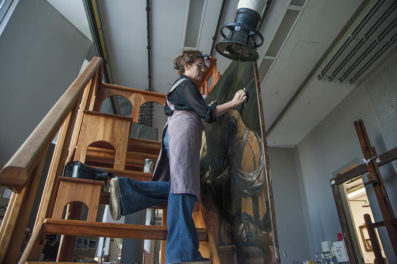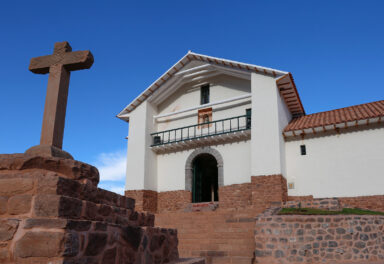As my colleague Foekje Boersma wrote here on the Iris last week, recent and ongoing debate about appropriate climates for collections has eroded the certainty of prescriptive approaches to reveal that no one solution can be applied universally.
As a member of the Getty Conservation Institute’s Managing Collection Environments initiative team and as course leader, I have been working with colleagues and instructors to develop a new type of course on collections care, one that aims to move beyond debates about relaxing “ideal” environmental conditions or specifications by considering the wider implications of collections preservation and the need for a richer evidence base for collection care decisions.
In response to conservators’ need for better technical information and an expanded skillset that includes negotiation and communication training, we’ve created the course Preserving Collections in the Age of Sustainability for mid-career professionals.
Knowing Isn’t Enough
For today’s conservation professional, knowing current standards for temperature or relative humidity is not enough. Conservators need to be able to modify generic standards and develop creative solutions that fit the needs of their collections and institutions. It is crucial for them to have up-to-date and emerging knowledge on collection care, especially in the areas of object response and climate management.
Once conservators have analyzed their situation, they need to be able to explain them to curators, administrators, and other museum professionals and collaboratively develop sustainable solutions. Understanding the implications of collection preservation actions from a variety of perspectives helps conservators influence and engage with other disciplines.
The MCE Preserving Collections course is designed for those who are confronted daily with climate issues and who are involved with making decisions about collections care at their institutions while understanding the assumptions in their own practice. Preserving Collections gives these mid-career professionals the opportunity to step away from the daily issues of their work and develop the skills needed to listen, influence, and lead.

Plotting a collection environment’s relative humidity with a moving average (three months), using standard EN 15757:2010. This enables a conservator to take into account the collection’s specific environmental history when making decisions about its care, rather than relying on rigid, one-size-fits-all thresholds to predict damage.
Extended Learning Environment
MCE’s Preserving Collections course presents its concepts in an extended learning environment—a three phase, nine-month course designed to allow time for newly acquired knowledge to be integrated with reflective practice and for participants to build networks within their professional sphere. The three connected phases of the course each have a different delivery method tailored to the tasks and goals for that phase. These phases include: 1) Online learning, 2) Intensive workshop, and 3) Distance mentoring. Each phase is intended to be a spring board to the next, providing “compound interest” by building upon what has gone before (the eighth wonder of the world in Albert Einstein’s opinion).
This week is the launch of the online learning phase and in anticipation of the beginning of the course, I’d like to share the structure and focus of the modules in which the participants will be engaged.
Online Learning in Three Stages
Participants access the online content through Moodle, a virtual learning environment developed for higher education. The system is structured to release information at particular stages, specifically divided into three periods.
1. Information gathering. The first period is centered around information-gathering tasks related to participants’ institutions. These range from compiling comprehensive institutional documents, to identifying challenges and professional development opportunities—areas for improved communication and collaboration at their institution. The course is intended to help foster open, effective working practices, which we recognize are highly dependent on good relationships. In rooting the coursework in the work of participants’ own institutions, our hope is that the benefits of the course extend to participants’ institutional colleagues and collaborators.
2. Readings and technical notes. The second module focuses on reading materials—documents specially commissioned for the course—including technical notes written by Getty Conservation Institute staff and commissioned from experts. These technical notes make highly scientific or complex information accessible, but still provide insight for those with a background in the topic.
In addition to technical material such as object responses to climate, the behavior of building fabric, and non-mechanical and HVAC systems, the course will introduce material on topics such as systems thinking, program briefing, and communication strategies. Very little has been written for the conservation field on these latter issues. Aligning technical data used for decision making with social and organizational approaches means that participants will consider sustainable strategies, negotiation, and leadership. The data collected during the first stage can be viewed in the light of this holistic approach to collections preservation.
3. Case studies. The final stage of the online phase immerses participants in case studies that have been developed in order to examine decision situations. Participants apply topical information to real-life situations in order to understand the tools required to develop critical examination, context-sensitive decisions, and interdisciplinary communication. This means an emphasis on processes and methods, rather than looking for “optimal” answers or values. This helps participants develop skills of analyzing and synthesizing uncertain and varied information that they can apply to their institutions.

A psychrometric chart showing environmental data for wet and dry seasons at a site. Analyzing the context and data in different ways allows conservators to employ different preservation strategies at the same site.
Preparation for the Intensive Workshop
Although the information-gathering tasks, readings and technical notes, and case studies are intended to work as stand-alone documents, they also help prepare participants for the course’s second phase: a two-week intensive workshop in June at the Pennsylvania Academy of Fine Arts in Philadelphia. The work undertaken in the online phase will allow participants to make the most of their time together—the uninitiated will have a firm foundation and those with some prior background can relate their experiences or apply their skills. Participants are able to focus on discussion of the prepared material instead of passively receiving new information.
I’ll report back on the eve of the workshop to share the goals and activities designed for this two-week intensive workshop.





As a Facilities Management professional for over 20 years at the Smithsonian, I look forward to gaining broad insight into emerging strategies for managing collections in a sustainable environment.
Can I have more informations?
Thank you
Best
Paola d’Orsi
Architect
Cultural Heritage Manager
I would like to know more about the next online learning course related to Managing Collections environments.
Thank you for your attention